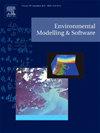Development of an alpine hydrological model considering the recharge of stream water to alluvial plain aquifers
IF 4.6
2区 环境科学与生态学
Q1 COMPUTER SCIENCE, INTERDISCIPLINARY APPLICATIONS
引用次数: 0
Abstract
The recharge of stream water to alluvial plain aquifers is of significant importance for alpine hydrology, yet it has not been adequately represented in hydrological models, limiting the reliability of hydrological simulation and future projection. This study developed a watershed model that can simulate this process with moderate complexity. A parsimonious method was proposed to calculate the stream water recharge fluxes into aquifers at the mountain front area, relying on the storage dynamics of alluvial plain groundwater. The inter-subbasin groundwater movement in seasonally frozen ground areas was also simulated to represent the connectivity of aquifers. A small headwater catchment in the northeastern Qinghai-Tibet Plateau was selected to validate the model. The simulation results indicated that the developed model can well reproduce multi-faceted observations, such as soil temperature profiles, the groundwater dynamics at different locations, streamflow at the catchment outlet, and the contributions of groundwater. In this case study, approximately 75 % of stream water from the permafrost areas infiltrated into alluvial plain aquifers in the seasonally frozen ground areas, and then gradually released to river, maintaining base flow during dry periods. This process buffers the movement of water from glacier and permafrost to the catchment outlet, and may delay the impact of global warming on discharge at the catchment outlet. The model developed in this study provides a reliable tool for assessing the effects of climate change on hydrological processes in alpine watersheds.
考虑河流向冲积平原含水层补给的高寒水文模型的建立
河流水对冲积平原含水层的补给对高寒水文具有重要意义,但在水文模型中尚未得到充分体现,限制了水文模拟和未来预测的可靠性。本研究开发了一个流域模型,可以以中等的复杂性模拟这一过程。提出了一种基于冲积平原地下水蓄水动态的山前地区河流补给含水层通量的简化计算方法。模拟了季节性冻土区地下水的跨盆地运动,以表征含水层的连通性。选取青藏高原东北部的一个小水源集水区对模型进行验证。模拟结果表明,所建立的模型能较好地再现土壤温度剖面、不同位置地下水动态、集水口流量和地下水贡献等多面观测结果。在本案例研究中,来自多年冻土区的大约75%的水流渗透到季节性冻土区的冲积平原含水层中,然后逐渐释放到河流中,在干旱时期保持基流。这一过程缓冲了水从冰川和永久冻土向汇水口的流动,并可能延缓全球变暖对汇水口排放的影响。本研究建立的模型为评估气候变化对高山流域水文过程的影响提供了可靠的工具。
本文章由计算机程序翻译,如有差异,请以英文原文为准。
求助全文
约1分钟内获得全文
求助全文
来源期刊

Environmental Modelling & Software
工程技术-工程:环境
CiteScore
9.30
自引率
8.20%
发文量
241
审稿时长
60 days
期刊介绍:
Environmental Modelling & Software publishes contributions, in the form of research articles, reviews and short communications, on recent advances in environmental modelling and/or software. The aim is to improve our capacity to represent, understand, predict or manage the behaviour of environmental systems at all practical scales, and to communicate those improvements to a wide scientific and professional audience.
 求助内容:
求助内容: 应助结果提醒方式:
应助结果提醒方式:


